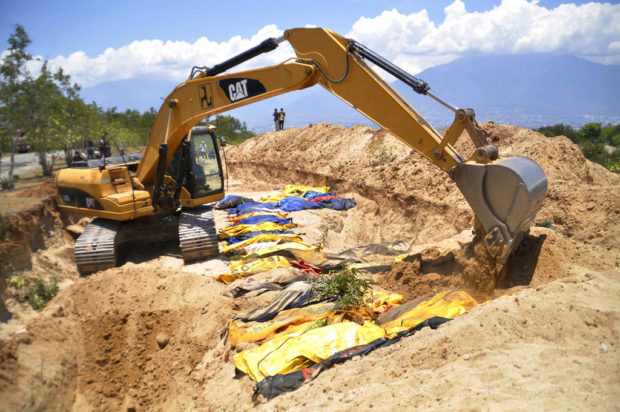
A heavy machine is used to bury tsunami and earthquake victims during a mass burial in Palu, Central Sulawesi, Indonesia, Tuesday, Oct. 2. 2018. Desperation was visible everywhere Tuesday among victims receiving little aid in areas heavily damaged by a massive earthquake and tsunami, four days after the disaster devastated parts of Indonesia’s central Sulawesi island. (AP Photo/Rifki)
PALU, Indonesia — For two days, Edi Setiwan helped pull the dead and the living out of a sea of mud and debris, all of them victims of one of Indonesia’s deadliest earthquakes in years.
And then, half-buried in the brown sludge, he saw two motionless bodies that broke his heart.
“I could see my father still embracing my sister,” Setiwan said on Monday, recounting the devastating moment he found them entombed in mud near their home in the city of Palu.
“I just cried,” he said. “I was able to save other people, but I was unable to save my own family.”
Friday’s 7.5-magnitude quake killed more than 1,200 people and destroyed thousands of homes, triggering a humanitarian crisis with survivors now in desperate need of food, water and fuel.
Buried alive
Most of the casualties were caused by the quake itself and a deadly tsunami that slammed into the coastline around Palu.
But hundreds of others were buried alive by a phenomenon called liquefaction, in which loose soil shaken by a quake gives way and collapses.
Disaster agency spokesperson Sutopo Purwo Nugroho said Palu’s Petobo neighborhood, where Setiwan lived, was devastated.
“There are still hundreds of victims buried in mud” in the area, he said.
When the massive quake struck on Friday, Setiwan said he was cleaning debris from another strong tremor that had cracked the walls of his home but left it standing just hours earlier.
‘Water, mud came out’
As the 32-year-old rushed outside, “the ground I stepped on cracked … water and mud came out, more and more from all directions.”
His neighborhood seemed to be sinking.
His wife and year-old daughter were fine, but other family members, friends and neighbors were missing.
He tried to reach his parents’ home, about 300 meters away, but the sea of mud that engulfed the area made it too hard to reach. With other villagers, he turned to saving whoever he could.
Villagers hurled ropes to people stuck in pools of thick mud that seemed like quicksand, and pulled them out by hand. Some of them saved his mother.
Rescuers arrive late
By Saturday, they had rescued 11 adults, including a pregnant woman, and two other children—although one later died.
Then they turned to the dead, recovering four bodies. It was on Saturday when Setiwan saw the bodies of his father and sister in the sludge, locked in the embrace that had marked the last moment of their lives.
Setiwan said the first government rescue teams arrived in his area on Sunday, but because the mud was still unstable, they were only able to take photos documenting the tragic scene.
On Monday, newly arrived rescue teams were confronting the behemoth task of trying to dig them out.